You can set financial goals that stick when you use clear steps and steady habits. You do not need complex systems. You only need simple planning, realistic numbers, and regular tracking. Wise Plans notes that people reach financial targets more often when they break goals into small and manageable steps. You can use the same idea to build strong financial goals at home.
Start with Your Current Financial Picture
Before you set new goals, you should understand your current situation. Write down your income, expenses, savings, and debt. This helps you see where your money goes each month. A clear picture gives you a strong base for building your goals. You can then decide what needs improvement.
Choose Clear Financial Targets
Your goals should be specific. Instead of saying you want to save money, write down the exact amount you want to save. Set a clear target like saving for an emergency fund, paying off a loan, or building monthly savings. Clear targets guide your actions and keep you focused.
Set Realistic Time Frames
A good financial goal needs a realistic deadline. You should avoid setting dates that create pressure. Choose time frames that match your income and lifestyle. For example, saving for a new appliance may take a few months, while paying off a large loan may take years. A balanced time frame helps you stay consistent.
Break Goals into Small Steps
Large goals can feel heavy. Break them into simple steps. For example, if you want to save a large amount, divide it into weekly or monthly savings targets. Small steps feel easier and help you stay motivated throughout the process.
Track Your Progress Regularly
Tracking helps you stay on the right path. Check your progress every week or month. Write down how much you saved or how much debt you paid. Adjust your plan if needed. Tech Food Trip notes that frequent tracking helps you stay aware of your habits and correct issues early.
Create a Simple Budget
A budget supports your goals. You should list your main expenses and check where you can reduce costs. Remove spending that does not add value. A budget gives you control of your money and helps you direct more funds toward your goals.
Use Separate Savings Accounts
Separate accounts make it easier to manage your goals. Keep one account for emergency savings and another for future plans. This avoids confusion and helps you see your progress clearly. You can label each account based on its purpose.
Automate Your Savings
Automation improves consistency. Set your bank account to move money to your savings at the same time each month. Automation removes the need for manual steps and ensures you save even on busy days.
Avoid Impulse Spending
Impulse spending slows your progress. You should give yourself time before making non essential purchases. Wait one or two days to decide if you really need the item. This small step protects your budget and keeps your goals on track.
Use Tools to Manage Money
Simple apps or spreadsheets help you record your income and expenses. Choose tools that feel easy to use. Avoid complex tools that take too much time. Clean and simple tools keep your plan organized.
Stay Flexible with Your Plan
Your financial needs may change. If your income goes up or down, adjust your goals. Flexibility helps you stay consistent even when life changes. Do not stop your plan. Adjust and continue.
Build an Emergency Fund
An emergency fund protects you from unplanned events. Aim for small savings first, then increase the amount over time. Even a small fund gives you confidence and reduces stress.
Review Your Goals Every Few Months
A short review keeps your goals fresh. Check what worked and what needs improvement. Change your amount or timeline if needed. A review also helps you celebrate progress, which boosts motivation.
Focus on One Main Goal at a Time
Working on too many goals at once divides your attention. Pick one major goal and give it priority. You can work on other goals later. A focused plan gives you faster results.
Keep Daily Spending Under Control
Daily habits affect long term goals. You should track small expenses like snacks, rides, or extra items. These add up quickly. Keeping track helps you avoid overspending.
Avoid Comparing Your Progress
Your financial situation is unique. Comparing your progress with others can create stress. Focus on your own path and make steady improvements.
Reward Yourself for Progress
Celebrating progress keeps you motivated. Choose small, affordable rewards when you reach milestones. This helps you stay excited about your journey.
Stay Patient
Some goals take time. Stay patient and continue your plan. Slow progress still moves you closer to your target.
Learn as You Grow
You can improve your knowledge with books, blogs, or courses. Financial learning helps you make better choices. Food Travel Library notes that consistent learning improves decision making and builds stronger financial habits.
Protect Your Savings
Avoid using your savings for daily expenses. Keep your emergency fund separate. Use it only when needed.
Discuss Goals with Family
If you share expenses with family members, discuss your plans. Clear communication helps everyone follow the same path and support the goal.
Reduce Debt Gradually
If you have debt, create a repayment plan. Pay the smallest or highest interest debt first. Both methods help you lower stress and make progress.
Focus on Long Term Stability
Short term changes help but long term habits secure your future. Build habits that you can follow for years. Long term consistency improves your financial strength.
These steps help you set financial goals that stay strong through the year. You can adjust each habit based on your routine and income. A steady plan and clear vision help you reach your targets with confidence.

